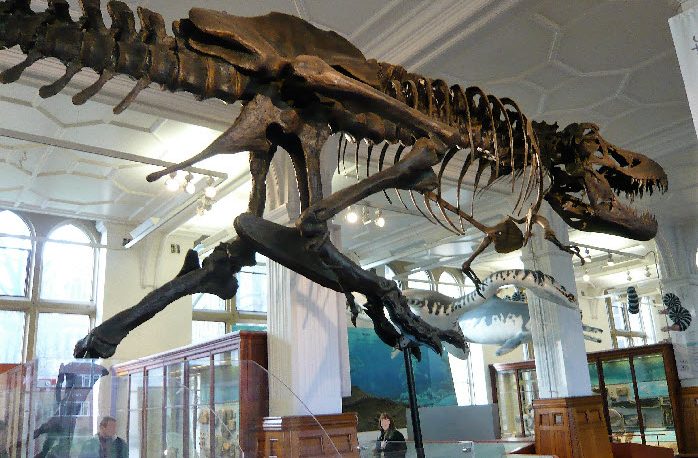(From https://www.dinox.org/trexslow.html)
The press love stories about dinosaurs, especially if it includes everyone’s favourite dinosaur Tyrannosaurus rex (T. rex), so it’s no surprise that a new science study in 2017 was well publicised. The study shows a T. rex’s running ability was limited by the strength of its leg bones. It couldn’t run in our gravity.
The leader of the study, Professor Bill Sellers from Manchester University, explained on BBC Breakfast how he started the study thinking he “would be able to show it would be a fast animalâ€. It looks like it could run. Other team members clearly thought the same since they had reconstructed the Manchester Museum T. rex in a running pose some years ago.
Palaeontologists have been arguing about the running ability of T. rex for decades and there have been two conflicting views. One school of thought depicted T. rex as a fast predator. Palaeontologists like Bakker, Christiansen and Paul have argued that the relatively long and gracile limbs of T. rex indicated it was a fast and active animal easily capable of running. This is a classic concept that has allowed films like Jurassic Park to portray T. rex as a fast active predator capable of chasing a jeep. There was another school of thought that described T. rex as a slower animal that perhaps scavenged or was an ambush hunter.
In order to find out if a running T. rex was really true Professor Sellers and his team began by digitising every single bone in the T. rex body, before putting it into a computer model complete with muscles based on information obtained from crocodiles, lizards and other animals. Once completed the whole model was placed in a computer program that used artificial intelligence and machine learning to make the animal move as fast as possible. Once they had done that they had a running T. rex.
However, the team spotted that the force on the hind limbs was just too big and the bones would have broken at that sort of speed. They had to slow the simulation down to a 12 miles per hour walk. They were forced to conclude that T. rex could only walk in our gravity, despite all the indications it could run.
Their paper, Investigating the running abilities of Tyrannosaurus rex using stress-constrained multibody dynamic analysis, written by William Sellers, Stuart Pond, Charlotte Brassey, Philip Manning and Karl Bates, was published as a free pdf in the science journal JeerJ.
There is however a strange paradox contained in the team’s calculations. The muscles of T. rex would enable it to run and yet if it did its hind limb bones would break. This is a strange animal indeed since bone grows in response to the forces imposed upon it. We know that a period in the reduced gravity of space allows bones to start to waste away, although they quickly recover their former strength when returned to normal gravity due to the higher stress levels on the bones.
If the muscles of T. rex were large enough to run then its hind limb bones should grow thicker until they were strong enough to match the forces imposed on them.
So why were the limb bones so thin? My answer to this paradox is that gravity was less during the T. rex’s time so the leg bones didn’t need to be any thicker. My latest palaeogravity calculations, based on T. rex and several other dinosaurs, indicates palaeogravity for T. rex was about 0.64g. This explains the paradoxical mismatch between its muscle strength and leg bone strength. I’d predict that the team’s computer model would show that a reduced gravity of about 0.64g would balance the muscle strength and the bone strength and allow their T. rex to run. Â
![]()




